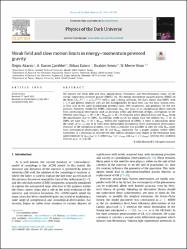Weak field and slow motion limits in energy–momentum powered gravity
Künye
Çamlıbel, Ali K., Akarsu, Ö., Katırcı, N., Semiz, İ. (2023). Weak field and slow motion limits in energy–momentum powered gravity. Physics of the Dark Universe, 42. Elsevier BV.Özet
We explore the weak field and slow motion limits, Newtonian and Post-Newtonian limits, of the
energy–momentum powered gravity (EMPG), viz., the energy–momentum squared gravity (EMSG) of
the form f (TµνT
µν ) = α(TµνT
µν )
η with α and η being constants. We have shown that EMPG with
η ≥ 0 and general relativity (GR) are not distinguishable by local tests, say, the Solar System tests;
as they lead to the same gravitational potential form, PPN parameters, and geodesics for the test
particles. However, within the EMPG framework, Mast, the mass of an astrophysical object inferred
from astronomical observations such as planetary orbits and deflection of light, corresponds to the
effective mass Meff(α, η, M) = M + Mempg(α, η, M), M being the actual physical mass and Mempg being
the modification due to EMPG. Accordingly, while in GR we simply have the relation Mast = M, in
EMPG we have Mast = M + Mempg. Within the framework of EMPG, if there is information about
the values of {α, η} pair or M from other independent phenomena (from cosmological observations,
structure of the astrophysical object, etc.), then in principle it is possible to infer not only Mast alone
from astronomical observations, but M and Mempg separately. For a proper analysis within EMPG
framework, it is necessary to describe the slow motion condition (also related to the Newtonian limit
approximation) by |peff/ρeff| ≪ 1 (where peff = p+pempg and ρeff = ρ +ρempg), whereas this condition
leads to |p/ρ| ≪ 1 in GR.

















